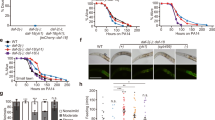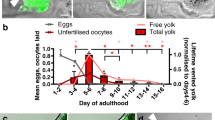Abstract
Severe dietary restriction, catabolic states and even short-term caloric deprivation impair fertility in mammals. Likewise, obesity is associated with infertile conditions such as polycystic ovary syndrome1,2. The reproductive status of lower organisms such as Caenorhabditis elegans is also modulated by availability of nutrients3,4. Thus, fertility requires the integration of reproductive and metabolic signals. Here we show that deletion of insulin receptor substrate-2 (IRS-2), a component of the insulin/insulin-like growth factor-1 signalling cascade, causes female infertility. Mice lacking IRS-2 have small, anovulatory ovaries with reduced numbers of follicles. Plasma concentrations of luteinizing hormone, prolactin and sex steroids are low in these animals. Pituitaries are decreased in size and contain reduced numbers of gonadotrophs. Females lacking IRS-2 have increased food intake and obesity, despite elevated levels of leptin. Our findings indicate that insulin, together with leptin and other neuropeptides, may modulate hypothalamic control of appetite and reproductive endocrinology. Coupled with findings on the role of insulin-signalling pathways in the regulation of fertility, metabolism and longevity in C. elegans and Drosophila3,4,5, we have identified an evolutionarily conserved mechanism in mammals that regulates both reproduction and energy homeostasis.
This is a preview of subscription content, access via your institution
Access options
Subscribe to this journal
Receive 51 print issues and online access
$199.00 per year
only $3.90 per issue
Buy this article
- Purchase on Springer Link
- Instant access to full article PDF
Prices may be subject to local taxes which are calculated during checkout





Similar content being viewed by others
References
Franks, S., Gilling-Smith, C., Watson, H. & Willis, D. Insulin action in the normal and polycystic ovary. Endocrin. Metab. Clin. North Am. 28, 361–378 (1999).
Legro, R. S. et al. Phenotype and genotype in polycystic ovary syndrome. Recent Prog. Horm. Res. 53, 217–256 (1998).
Tissenbaum, H. A. & Ruvkun, G. An insulin-like signaling pathway affects both longevity and reproduction in Caenorhabditis elegans. Genetics 148, 703– 717 (1998).
Hsin, H. & Kenyon, C. Signals from the reproductive system regulate the lifespan of C. elegans. Nature 399, 362–366 (1999).
Bohni, R. et al. Autonomous control of cell and organ size by CHICO, a drosophila homolog of vertegrate IRS1-4. Cell 97, 865 –875 (1999).
Lavan, B. E., Lane, W. S. & Lienhard, G. E. The 60-kDa phosphotyrosine protein in insulin-treated adipocytes is a new member of the insulin receptor substrate family. J. Biol. Chem. 272, 11439–11443 (1997).
Lavan, B. E. et al. A novel 160 kDa phosphotyrosine protein in insulin-treated embryonic kidney cells is a new member of the insulin receptor substrate family. J. Biol. Chem. 272, 21403– 21407 (1997).
Withers, D. J. et al. Disruption of IRS-2 causes type 2 diabetes in mice. Nature 391, 900–904 ( 1998).
Withers, D. J. et al. Irs-2 coordinates Igf-1 receptor-mediated beta-cell development and peripheral insulin signalling. Nature Genet. 23 , 32–40 (1999).
Ogg, S. et al. The Fork head transcription factor DAF-16 transduces insulin-like metabolic and longevity signals in C. elegans. Nature 389, 994–999 (1997).
Morita, Y. et al. Requirement for phosphatidylinositol-3-kinase in cytokine-mediated germ CEll survival during fetal oogenesis in the mouse. Endocrinology 140, 941–949 ( 1999).
Vassen, L., Wegrzyn, W. & Klein-Hitpass, L. Human insulin receptor substrate-2 (IRS-2) is a primary progesterone response gene. Mol. Endocrinol. 13, 485–494 (1999).
Richards, R. G., DiAugustine, R. P., Petrusz, P., Clark, G. C. & Sebastian, J. Estradiol stimulates tyrosine phosphorylation of the insulin-like growth factor-1 receptor and insulin receptor substrate-1 in the uterus. Proc. Natl Acad. Sci. USA 93, 12002–12007 (1996).
Schwartz, M. W., Baskin, D. G., Kaiyala, K. J. & Woods, S. C. Model of the regulation of energy balance and adiposity by the central nervous system. Am. J. Clin. Nutr. 69, 584– 596 (1999).
Unger, J. W. & Betz, M. Insulin receptors and signal transduction proteins in the hypothalamo–hypophyseal system: a review on morphological findings and functional implications. Histol. Histopathol. 13, 1215–1224 (1998).
Unger, J. W. & Lange, W. Insulin receptors in the pituitary gland: morphological evidence for influence on opioid peptide-synthesizing cells. Cell Tissue Res. 288, 471– 483 (1997).
Woods, S. C., Stein, L. J., McKay, L. D. & Porte, D. Chronic intracerebroventricular infusion of insulin reduces food intake and body weight of baboons. Nature 282, 503– 505 (1979).
Foster, L. A., Ames, N. K. & Emery, R. S. Food intake and serum insulin responses to intraventricular infusions of insulin and IGF-1. Physiol. Behav. 50, 745–749 (1991).
Flier, J. S. What's in a name? In search of leptin's physiological role. J. Clin. Endocrin. Metab. 83, 1407–1413 (1998).
Schwartz, M. & Seeley, R. Neuroendocrine responses to starvation and weight loss. New Engl. J. Med. 336, 1802–18011 (1997).
Ahima, R., Prabakaran, D., Mantzoros, C. et al. Role of leptin in the neuroendocrine response to fasting. Nature 382, 250– 252 (1996).
Chehab, F. F., Lim, M. E. & Lu, R. Correction of the sterility defect in homozygous obese female mice by treatment with the human recombinant leptin. Nature Genet. 12 , 318–320 (1996).
Chen, H. et al. Evidence that the diabetes gene encodes the leptin receptor: Identification of a mutatioan in the leptin receptor gene in db/db mice. Cell 84, 491–495 ( 1996).
Lee, G. H. et al. Abnormal splicing of the leptin receptor in diabetic mice. Nature 379, 632–635 (1996).
Vaisse, C. et al. Leptin activation of Stat3 in the hypothalamus of wild-type and ob/ob mice but not db/db mice. Nature Genet. 14, 95–97 ( 1996).
McCowen, K. C., Chow, J. C. & Smith, R. J. Leptin signaling in the hypothalamus of normal rats in vivo. Endocrinology 139, 4442– 4447 (1998).
Szanto, I. & Kahn, C. R. Selective interaction between leptin and insulin signaling pathways in a hepatic cell line. Proc. Natl Acad. Sci 97, 2355–2360 (2000).
Berti, L., Kellerer, M., Capp, E. & Haring, H. U. Leptin stimluates glucose transport and glycogen synthesis in C2C23 myotubes: evidence for a PI 3-kinase mediated effect. Diabetologia 40, 606–609 (1997).
Cohen, B., Novick, D. & Rubinstein, M. Modulation of insulin activities by leptin. Science 274, 1185–1188 ( 1996).
Fredrich, R. C. et al. Leptin levels reflect body lipid content in mice: evidence for diet-induced resistance to leptin action. Nature Med. 1, 1311–1314 (1995).
Acknowledgements
We are grateful to C. Cahill for preparation of pituitary sections; A. Parlow for antibodies to pituitary hormones; A. Dunaif for testosterone measurements; and D. Hess for helpful discussions of murine sex hormones.
Author information
Authors and Affiliations
Corresponding author
Rights and permissions
About this article
Cite this article
Burks, D., de Mora, J., Schubert, M. et al. IRS-2 pathways integrate female reproduction and energy homeostasis. Nature 407, 377–382 (2000). https://doi.org/10.1038/35030105
Received:
Accepted:
Issue Date:
DOI: https://doi.org/10.1038/35030105
This article is cited by
-
Sex differences in energy metabolism: natural selection, mechanisms and consequences
Nature Reviews Nephrology (2024)
-
Insulin resistance in polycystic ovary syndrome across various tissues: an updated review of pathogenesis, evaluation, and treatment
Journal of Ovarian Research (2023)
-
Visfatin in the porcine pituitary gland: expression and regulation of secretion during the oestrous cycle and early pregnancy
Scientific Reports (2023)
-
Role of CPXM1 in Impaired Glucose Metabolism and Ovarian Dysfunction in Polycystic Ovary Syndrome
Reproductive Sciences (2023)
-
Developmental programming: gestational testosterone excess disrupts LH secretion in the female sheep fetus
Reproductive Biology and Endocrinology (2020)
Comments
By submitting a comment you agree to abide by our Terms and Community Guidelines. If you find something abusive or that does not comply with our terms or guidelines please flag it as inappropriate.



